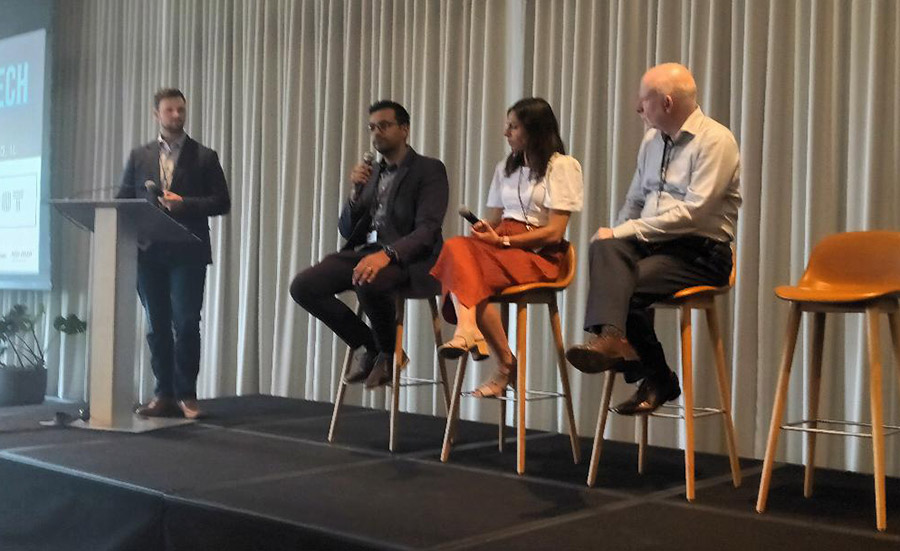Contractors are losing out big-time on efficiencies that would benefit projects because they aren’t tapping into 95% of the information that BIM can provide.
That’s the assessment of Tessa Lau, one of the speakers at the BuiltWorlds Construction Tech Conference 2023, held July 18-20 in Chicago.
Lau, founder of Dusty Robotics, which used a robot to print full-scale floor plans on the concrete at Exchange, a 16-story tower being built from the top down in Detroit, said it’s easy to see why this information is not being accessed or used.
“[That’s because] it’s so painful,” she said. “People are getting up and down from their knees 5,000 times a day—so they do the minimum.”
Making it easier on workers by using QR codes that are printed and placed on the floor by Dusty's robots could allow access to more robust information, she said.
“What if they [workers] can stand in front of a QR code, snap a picture on their phone, and pull up information that’s relevant to their job in their location?” Lau said.
Using QR codes to pull up part lists, work instructions in English or another language and checking boxes to indicate when work in a location is completed and simultaneously alerting the office is the future of skilled labor, she said.
Better use of BIM, how to increase adoption of technologies, the growing use of data and who owns it and the future of capital investment in construction technology overall were some of the other topics that emerged at the conference.
Boosting Adoption
The challenges in implementing and encouraging contractor employees to try, and perhaps, adopt new technologies, also was a hot topic.
Ariel Castillo, strategic process and VDC specialist for Miller-Davis Company, asked the audience members in one session whether they like change, and only about half raised their hands, which he said signifies why it can be difficult to bring new technologies into play—even among an audience geared toward embracing technology.
Letting project managers steer the course in deciding what technologies to use encourages adoption, said Hamzah Shanberi, director of innovation for contractor Haskell.
“Even if we find a technology that’s the bees’ knees, we don’t push it,” he said. “Our project managers get to choose what to implement on their project and how to drive it. I find that’s more appealing for our project managers.”
His strategy also is to present them with different options.
“When they pick it, it becomes their idea and then we have their buy-in," he said.
The stresses of day-to-day work are one reason why there may be resistance to new technologies, according to another panelist.
“I don’t think a lot of our teams are looking to dabble in technology when they have all these construction [problems] to solve,” said Jason Tschetter, senior director, Field Technology & Innovation for Mortenson Construction. “You don’t want to add more stress, but [at the same time] you want to keep the company innovative—it’s a balance.”
Tschetter said megaprojects can be a good place for testing new technologies.
“A lot of innovation comes out of megaprojects,” he said. “You have the sub [contractors]s onboard, and you work out the kinks on the first- and second-floors. By the time you get to the third- and fourth-floors, you have a case study. Look for these types of projects to showcase opportunities.”
New Tech or Old?
A discussion around whether it’s better to focus on making better use of existing technologies or adopting new ones drew varied responses.
“We have to hone in on things we have that will get better over time,” said Danielle O’Connell, senior director of Emerging Technology at Skanska USA Building.
She said IT departments can be partners in bringing in new technologies, but the audience indicated by a show of hands that IT departments in construction firms often don’t have research or innovation budgets.
Often, the IT department’s imperative “is to make sure we have the lights on and if Procore goes down, there is a system to overcome that,” O’Connell said.
“We’re evaluating 40 new technologies [at Skanska]" she added. “And [our IT team] says 'We already have 300 technologies we’re maintaining.' It's scary for them.”
Taking another view, Christian Burger, president of Burger Consulting Group, said lagging adoption of new technologies overall could deter capital investment. He said capital investment in construction technologies has grown immensely compared to 20 years ago. He described the level back then as “equivalent to a cup of coffee.”
“But now, I’m seeing numbers in the billions of dollars invested in construction tech,” he said. “Big bets are being placed. These entities are expecting a return on their capital investment. If the industry doesn’t rise to the occasion they are going to go and find a different industry.”
The panelists noted an abundance of new technologies. O'Connell cited 50 reality capture companies that have emerged as an example.
"It's going to be interesting to see who's going to make it," she said.
Data Wars Expected
Some new technologies are geared to accessing and using data, which Burger said will lead to issues that will need to be resolved.
“There is going to be a war over data, maybe there already is,” he said, predicting issues will arise over who owns or monetizes data.
He envisions there will be tangled webs to unravel.
“Think about this,” he said. “A general contractor asking subs to use their systems and you're putting your data into their systems and then being asked by owners to put your data in their systems.”
Future Growth
Whether they are working toward better using current technologies or adopting new ones, Burger says companies that are making tech investments are better positioned to thrive.
"The firms that I see are succeeding today have a reasonable investment in technology," he said "But, for every one of those firms, there are 20 that are 20 years back in their tech stack. They are the ones trying to save their way to prosperity. The tech gap [between these companies] is getting to be rather significant.”




Post a comment to this article
Report Abusive Comment